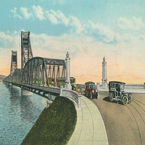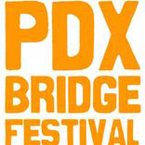A Mighty Span
A Mighty Span
A Mighty Span imagines a live radio broadcast of the opening ceremonies for the
Interstate Bridge, the first to connect Portland, Oregon, and Vancouver, Washington, across
the Columbia River, 14 February 1917. Invited by the PDX Bridge Festival to celebrate
the 100th anniversary of the opening of the Interstate Bridge.
Exhibitions
 (un)continuity: ELO 2020 Virtual Exhibition
(un)continuity: ELO 2020 Virtual Exhibition
Juried exhibition, international
Electronic Literature Organization Conference and Festival
University of Central Florida
Orlando, Florida
16-30 July 2020
 Clark County Historical Museum
Clark County Historical Museum
Invited sound art installation, regional
Vancouver, Washington
4 March-2 May 2017
Included with the "Bridging the Gap: The History of the Interstate Bridge" exhibition.
 Interstate Bridge 100th Anniversary Celebration
Interstate Bridge 100th Anniversary Celebration
Commissioned installation, regional
Jantzen Beach, Oregon
11 February 2017
Commissioned by PDX Bridge Festival, with TenBridge Partners, the Red Lion on the River, and
the Oregon Historical Society, as part of the 100th anniversary celebration of the
Interstate Bridge opening. PDX Bridge
Festival Facebook.
Background
I was commissioned by PDX Bridge Festival, with TenBridge Partners, the Red Lion on the River, and the Oregon Historical Society, to create a sound work that would help celebrate the 100th anniversary of the opening of the Interstate Bridge, the first to connect Portland, Oregon, and Vancouver, Washington, across the Columbia River, 14 February 1917.
Metadata
Object: Audio file
Format: mp3
Bit Rate: 356kbs
Duration: 15:00
Created: 2017
Creator: John F. Barber
Conceptual Framework
The conceptual framework for A Mighty Span involves a live radio broadcast from the lift span of the Interstate Bridge where a temporary platform was erected in the roadway. State and local leaders deliver speeches. The ribbon is cut. The bridge is officially opened. Automobiles and pedestrians move across the new bridge, back and forth between Oregon and Washington. We hear these events and others in the fifteen minute radio broadcast.
Part Fiction, Part Fact
The content of A Mighty Span is factual. The container, the radio broadcast, is
fictional.
Reports and editorials published in Washington and Oregon newspapers the day of and the day after the bridge opening provide many historical details about the ceremony, the setting, the speeches, and what was seen and heard. For example, the opening ceremony, on the lift span of the bridge, was short, fifteen minutes, designed so to allow people and traffic to begin moving across the river. Only one speech was delivered on the bridge, that by Mr. Samuel Hill. Other speeches by community and state leaders were delivered at Vancouver Park (now Ester Short Park), soon after the opening ceremony on the bridge and following a parade of automobiles, marching bands, and several thousand pedestrians throughout downtown Vancouver. Sounds and sights were abundant.
There was, however, no radio coverage, or broadcast, associated with the bridge opening ceremonies. In truth, there was no radio technology available in Washington or Oregon. The first American radio broadcast might have been in 1900. The first radio station was established in 1920. The earliest voice broadcast from Portland was 20 March 1921 by Charles Austin. One of Portland's first radio station licenses was granted to The Portland Telegram who offered their first broadcast on 21 November 1921. The Oregonian was granted the ninety-eighth radio license issued in the United States and began broadcasting as KGW on 22 March 1922. Vancouver's first radio station, KVAN, began broadcasting in 1939. [1] Had there been radio in the area in 1917, it most likely would have been directed toward supporting the US World War I efforts.
So, in 1917, radio was not a part of life in Portland or Vancouver. Still, the idea provides a wonderful context and storytelling opportunities for A Mighty Span. To take advantage, I moved all speeches to the bridge in order to maintain the bridge as the focus of the listening context and to maintain the timeframe of the opening ceremony. Quoted remarks of the speakers were used as reported.
I placed my fictional news commentator on the bridge, near the temporary platform, where he could see and hear the speeches and other events. A mobile reporter was at the south end of the bridge, the Oregon side. Another was at the north end, in Vancouver, Washington. Remarks by the news commentator and the two reporters were created from my research of historical records.
Remarks, by both speakers and radio announcers, were incorporated into a script. Recordings
were, when possible, collected from individuals holding the same positions or similar to the
historic speakers, all reading from this script. Otherwise, I utilized local voice actors
who volunteered their time and effort. The cast included . . .
Eric Newsome as Announcer
Toni Lima as Cameron Cameron, reporter
Eli Campbell as Carrie Phillips, reporter
Ira Kourtum as Mr. Joseph Joseph, construction superintendent
Martin John Gallagher as Rufus Holman, Multnomah County Commissioner
Chris Porter as James Withycombe, Oregon Governor
Todd Tolces as H. Russell Albee, Portland Mayor
Mayor Timothy Levitt as Milton Evans, Vancouver Mayor
Curt Hanson as Edgar B. Piper, editor of The Oregonian
Sam A. Mowry as Frank Branch Riley, organizing committee
John Barber as Sam Hill, "roadmaster of the Northwest"
Notes
[1] See Portland's Radio
History for an excellent account and radio and television history in Portland,
Oregon.
KVAN radio had several names and broadcast frequencies . . . KVAN (1939-1959; 910 AM), KGAR (1963-1981; 1480 AM), KVAN (1981-1989; 1550 AM), KMJK (1989-1991; 1550 AM), and KVAN (1991-2000; 1550 AM). Willie Nelson hosted "The Western Express" show on KVAN, 1956-1957. In 1998, KVAN radio was sold to a Portland, Oregon, media group. The station was moved there, even though the broadcast license remains in Vancouver. Throughout its history, KVAN radio was truly a "local station" because its low-powered broadcast could not carry beyond the immediate vacinity of Vancouver.
Influences
The major influence behind the conceptual framework for A Mighty Span is the You Are There OTR documentary / drama series acclaimed for its dramatizations of historical events using the international Columbia Broadcasting System (CBS) news staff. Each episode placed a news commentator and mobile reporters at the scene of an historical event. Historical accuracy and realistic sound effects were hallmarks of the series. Both contributed to a sense of hearing the events live as they unfolded.
Bridge Background
NOTE: The information below about The Interstate Bridge, its background, details, and timeline is abbreviated. For a more thorough exploration see the Interstate Bridge segement of The Historic Pacific Highway in Washington website, maintained by Curt Cunningham.
The Interstate Bridge, AKA Columbia River Interstate Bridge, Portland-Vancouver Interstate Bridge, Vancouver-Portland Bridge, and I-5 Bridge, was opened 14 February 1917. It was the first automobile bridge across the Columbia River between Portland, Oregon, and Vancouver, Washington, and only the second to span the river at all, after the Wenatchee Bridge, built in 1908. Originally owned by Multnomah County, Oregon, and Clark County, Washington, the bridge was purchased by the states of Oregon and Washington in 1928. The name, "Interstate Bridge," described its location, at the border of Oregon and Washington, and its function: to carry traffic across the Columbia River, which divided the two states.
Bridge Details
The original bridge, the current northbound portion of the twin pair, was 3,538 feet in length, and comprised of thirteen steel spans with three measuring 275 feet in length and the remaining ten measuring 265 feet. One of the 275 foot spans was a vertical lift capable of rising upwards 136 feet between towers that rise 190 feet above the roadway. When fully raised, the span provides 176 feet of clearance for river traffic, below.
The steel bridge was built atop pile caps, concrete slabs surrounding the tops of wooden pilings driven approximately seventy feet into the river bottom.
The original paved roadway was thirty-eight feet wide, with a five foot sidewalk.
Total cost: $1,700,000, which included the cost of approaches, lights, fences, and other features.
A toll of 5 cents per vehicle, or horse and rider, was charged from opening day, and continued until 1928, when the bridge was purchased from Multnomah and Clark counties by the states of Oregon and Washington.
Electric streetcars ran back and forth across the bridge from opening day until 3 September 1940. A dual-gauge track bed accommodated the different track gauges of the Portland and Vancouver streetcar lines. Before the bridge, Portland offered a Vancouver streetcar line which ran to Hayden Island. From there, passengers boarded a ferry owned and operated by the streetcar line, and continued across the Columbia River to Vancouver.
Bridge Timeline
Prior to 1915 Traffic across the Columbia River between Portland, Oregon, and Vancouver, Washington, was handled by a ferry system operated by the Pacific Railway, Power & Light Company. The ferry itself, City of Vancouver, was overcrowded. Citizens in both Portland and Vancouver advocated for a bridge to connect their cities, and states.
1915
Construction began in March, with money from the sale of bonds in Multnomah and Clark
Counties.
14 February 1917
Bridge opened as a single bridge, the one currently carrying northbound traffic. Shortly
before the bridge opened, two streets in North Portland, Maryland Avenue and Patton Avenue,
planned as the main route to and from the bridge, were renamed Interstate Avenue. The bridge
deck included a roadway for automobiles, a walkway for pedestrians, and tracks for electric
streetcars. Toll charges were used to repay the construction costs.
1957
The bridge became part of the new Interstate 5, itself part of the national Interstate
Highway System.
1958
A second, twin bridge opened (the one currently carrying southbound traffic). The new bridge
was built with a longer (531 feet) humped section mid-span that provided seventy-two feet of
vertical clearance for river traffic, thus minimizing bridge openings. With the new bridge
open, the original bridge was closed for rebuilding to give it a matching humped section.
1960
Both bridges opened concurrently. Tolls were reinstated: 20 cents for cars, 40 cents for
light trucks, and 60 cents for heavy trucks and buses. Tolls were removed in 1966 after
construction costs were repaid.
1982
Interstate Bridge added to the National Register of Historic Places as the
"Portland-Vancouver Highway Bridge."
Artist Statement
A Mighty Span celebrates the 100th anniversary of the Interstate Bridge with an imagined radio broadcast of the opening ceremonies, 14 February 1917. I have imagined this broadcast based on the speeches and commentary reported in local newspapers. The names and words of the speakers are real. Their voices are provided by local actors.
The purpose of A Mighty Span is to engage listeners in an event one hundred years in the past. Through their experience of speech and other sounds, listeners should be able to imagine being on the Interstate Bridge the day of its opening, and experiencing some of the spectacle and pride associated with this mighty span across the Columbia River.